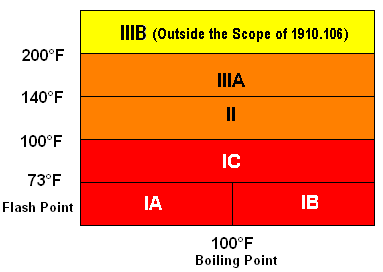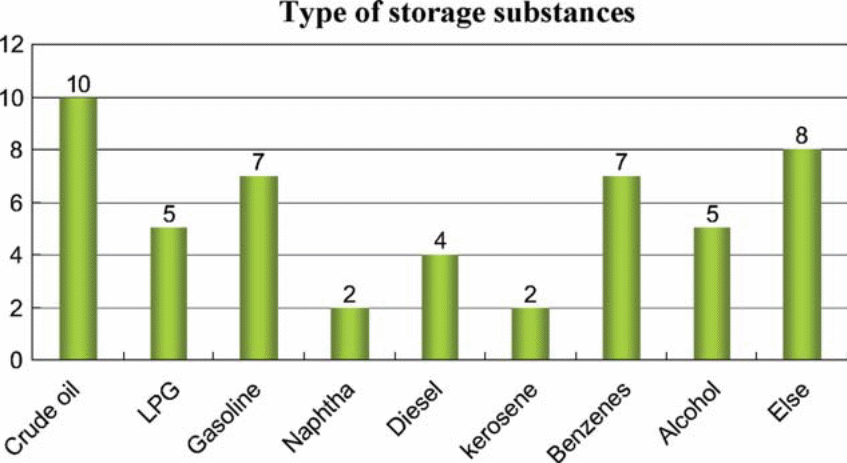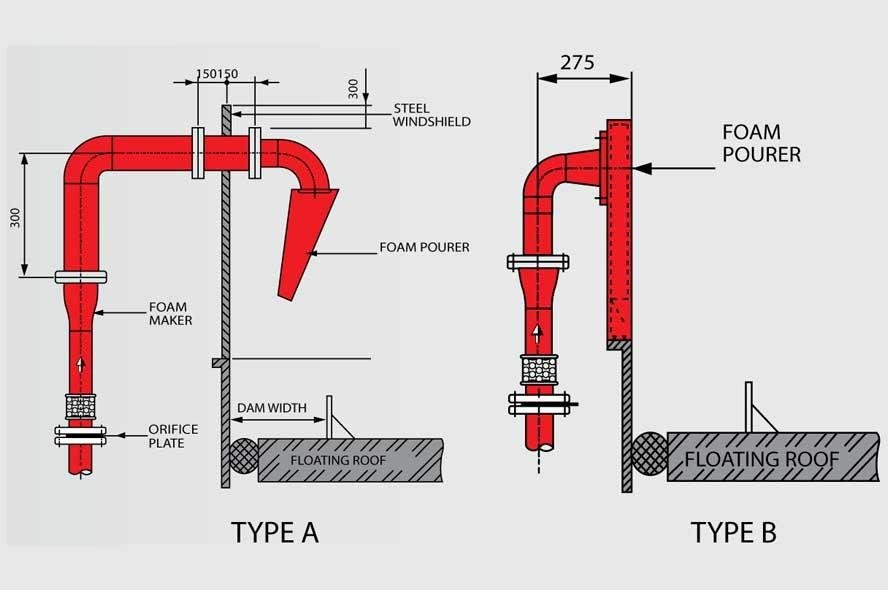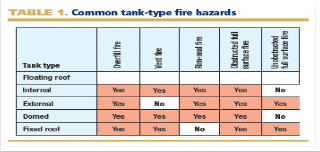Introduction
The dangers and risks involved in handling flammable and combustible liquids and gases call for extra vigilance in the processes of packaging and transporting. Since harmful effects associated with careless handling are irreversible and long-term in nature, safety precautions must be considered.
As such, firms and governments have put standards and measures to ensure safety in the whole process of handling flammable liquids. This paper focuses on the process of storage, facilities required, risks involved, as well as some security measures that have been put in place to reduce the occurrences of disasters.
Definitions
The flash point, for example, is the temperature where the amount of vapor generated is enough to support combustion. On the other hand, the boiling point is the point where the saturated vapor pressure matches the atmospheric pressure. Flammable liquids are liquids containing more than one percent of a substance whose flash point is below 100oF.
As such, combustible liquids have a flash point at, or above 100oF (National Fire Protection Association 2). The following table offers a criterion for determining the class of a particular liquid given their flash point and boiling point. Classes 1a, 1b, and 1c represent the flammable liquids; classes II and IIIa represent combustible liquids; while class IIIb is neither combustible nor flammable.

A portable tank is a closed container having a carrying capacity over 60 gallons and its design is not intended for use in a fixed status. Additionally, a pressure vessel refers to a storage compartment whose design enables it to operate at pressures above 15 p.s.i.g. Finally, a container refers to a vessel that is airtight; hence, does not allow substances to escape at ordinary temperatures.
Type of Storage Substances
Storage substances belong to various categories, which determine the means for storage, transportation, as well as safety measures. According to various sources, the common types of storage substances include the following: Crude oil, LPG, Gasoline, Naphtha, Diesel Kerosene, Benzenes, and Alcohol among others as shown below.

Storage facilities requirements
Flammable and combustible liquids are stored in tanks which may vary in size and design, the NFPA provide standards for the storage of these gases, there transportation and their use. As mentioned before, these standards aim at preventing the hazards that can result from such liquids.
Storage tanks
Storage tanks should be made of steel or other approved nonflammable materials for underground storage. For concrete tanks, it is mandatory that a special interior lining is added, and excellent engineering practices conducted to allow for sound storage. In addition, operating pressures are not supposed to exceed that which the design allows (National Fire Protection Association 6).
Underground tanks
Atmospheric tanks must not exceed 2500 gallons where their original design was for underground, but for some reason, they were placed above the surface. Furthermore, it is important to avoid using them for storing liquids above their boiling points (National Fire Protection Association 12). In practice, the operating pressure must never exceed the design pressure.
Surface tanks
For above ground tanks, the distance between any two tanks should not be less than three feet. In case of unstable liquid, the distance to maintain between tanks must be beyond half the sum of their diameters. For liquefied petroleum gas, the distance between the LPG containers and the other liquid containers must exceed twenty feet (National Fire Protection Association 15). In addition, above the ground tanks require normal and emergency venting to prevent rapture or vacuum formation.
Examples of Storage Tanks
Fixed roof tanks
Fixed roof tanks are categorized as cone roof columns and dome roof tanks. These tanks are used for the storage of flammable liquids, and are designed with internal pressures of up to 1 bar. However, they can be used for storage of non-volatile or inflammable substances including water, pulp, and acids among others.
Internal and Open-top Floating Tanks
These tanks are provided with protection seals and emission control devices, which improve safety while handling flammable storage substances. Internal floating tanks are manufactured using steel, aluminum, or synthetic materials, and are easy to manufacture, erect, as well as maintain. On the other hand, external tanks are made of welded steel in order to sustain the high pressures from storage liquids.
Other vessels
Other than storage tanks, there exist other storage facilities such as container and portable storage facilities (National Fire Protection Association 11). However, only approved containers are used so as to maintain high levels of safety.
Types of hazards and security measures
An excellent plan for safety when using flammable liquids must feature some components, which include control of ignition sources, proper storage, fire control, as well as safe handling.
Fire
While proposing for security measures, one should first understand the causes of fires, and establish the best safety measures to follow.
Ignition Sources
Static electricity
Formation of static electricity is dangerous since the tank can explode or a fire can start as a result of the electrostatic energy (“UNL: Environmental Health and Safety” 20). As such, it is important to prevent static energy from producing sparks: This requires that storage containers are grounded or bonded to prevent sparking.
Open flames
As a regulation, storage areas are strictly nonsmoking zones because cigarette smoking is a source of open flame. Welding, lighting, and hot surfaces are also other sources of open flames (“UNL: Environmental Health and Safety” 32). Such activities must be a safe distance away from the operating environment of flammable liquids.
Electrical Spark
On several occasions, sparks occur as a result of minor electrical faults such as short circuits, and may ignite other sources of energy. There are several sources of electrical spark generation such as in welding facilities, faulty electrical gadgets, and battery cells. As such, fire regulations stipulate that flammable liquids must be stored in airtight vessels that will protect flammable liquids from ignition.
Suppression Systems
Fire suppression systems are designed to control the spread of broken out fires. This minimizes on the destructive effects of fire since such fires are controlled and extinguished before they are fully grown. The following shows an example of fire suppression system for floating roof tanks.

Common Tank-type Hazards
The following table shows the incidences of fire hazard with the use of various types of storage tanks.

- Overfill fires – Occur due to spillages resulting from tank overfill.
- Vent Fires – Occur as a result of vent failure or blockages.
- Rim Seal Fires – Occur as a result of broken tank seals.
- Full Surface Fire – Occur due to surface ignition of storage liquids.
Case Study
- Place: Delaware, USA.
- Date: July 17, 2001.
- Cause: Spark from maintenance work.
- Type: fixed roof.
- Losses: 8 injuries and 1 death.
- Outcome: Significant offsite environmental impact.
Lesson Learned
- Intense procedures must be followed before conducting periodic maintenance works.
- Risk assessment should be conducted.
- Training and competence of personnel should be done.
- Elimination of flammable atmosphere should be done including isolation, purging, gas testing, as well as control of ignition sources.
- Adherence to minimum separation distances given in codes and standards.
- Adequate separation from tanks to site boundary, process equipment, loading areas, and buildings should be provided.
Health hazards
Many of these liquids are corrosive and undergo multiple reactions if exposed to other chemical components like oxidizing agents or when stored improperly. Therefore, people handling these liquids must be physically present and wear protective clothing (“Environmental Health and Safety Executive” 3).
Eye contact with such liquids may result in a burning sensation, irritation and possibly eye damage (“UNL: Environmental Health and Safety” 10). Similarly, repeated exposures may result in target organ toxicity, which may result in the failure of such organs or death.
Environmental hazards
Spillages are a key pollution that threatens the ecosystem where the quantities are high enough. The liquids may result in chronic toxicity whereby they cause adverse effects on aquatic life when exposed in an aquatic ecosystem (“Environmental Protection Agency” 7). Improper disposal or accidental spillages are causes of soil and air pollution.
General Use and Storage Considerations
It is of paramount importance to understand that the handling of these liquids is not restricted to specialized firms or individuals. The substances are produce for use by the public, as well as other unspecialized individuals; therefore, safety regulations need to consider this factor (“UNL: Environmental Health and Safety” 22). In connection, protection from ignition sources is crucial during important processes like extraction, centrifuging, and grinding (“UNL: Environmental Health and Safety” 16).
Conclusion
As established, liquids are essential in the daily lives, but also pose a significant level of risk in people’s lives, as well as the environment. Therefore, it is important that all such risks are controlled so as to have a safe environment that is free from hazards associated with storage of liquids. In conclusion, liquids can be hazardous to both individuals and the environment; hence, it is necessary to take appropriate measures for preventing the creation of hazards.
Works Cited
“Environmental protection Agency (EPA).” Release: 40 CFR 302. 116.4 (2010): n.pag. California Fire Code: Chapter 27. Web.
Health and Safety Executive: Storage of Flammable Liquids 2002. Web.
National Fire Protection Association (NFPA): Code 30 2006. Web.
“UNL: Environmental Health and Safety.” Environmental Health and Safety 402. 472 (2000): n.pag. UNL. Web.